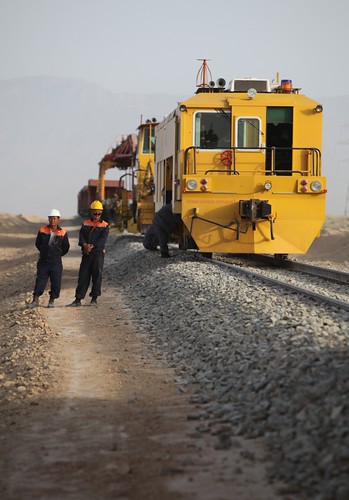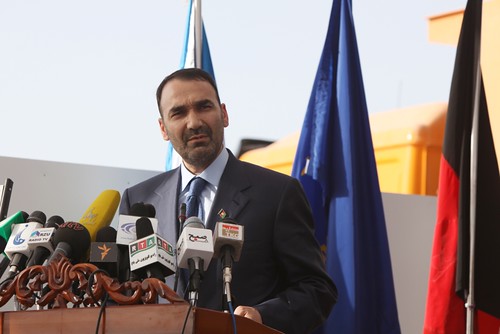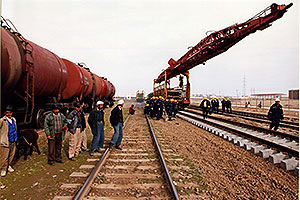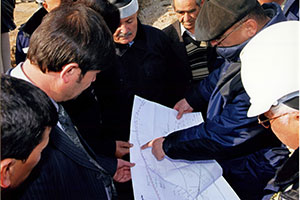Discussion of the Mazar-i-Sharif railway project at Registan. Mixing railways and Afghanistan, though, is sure to bring out the Great Game in all of us. Sigh.
Mazar-i-Sharif
ADB railway inauguration on YouTube
01 June 2010 — Asian Development Bank (ADB) President Haruhiko Kuroda recently inaugurated a 75-kilometer stretch of railway line that connects the Afghan city of Mazar-e-Sharif to the country’s bustling northern border with Uzbekistan.
Hayratan railway ribbon-cutting and construction works
Photographs from the American Embassy in Kabul, which has a Flickr site with lots more pictures of the Hairatan Rail Line Ribbon Cutting Ceremony on May 25.
US ambassador at Hayratan
U.S. Ambassador Karl Eikenberry joined the president of the Asian Development Bank (ADB), Minister of Finance, Minister of Mines, Minister of Transportation and Civil Aviation, and fellow Ambassadors from Japan, Finland, and Uzbekistan at a ribbon-cutting ceremony inaugurating the Hairatan Rail Line. Hairatan is located in the Balk Provience. This rail link is the first phase of a larger rail network planned for the country, including links to Herat, Tajikistan and Pakistan, and improves connectivity and increase trade throughout the region, supporting growth and cutting poverty.
Source: American Embassy Kabul on Flickr
May 25, 2010: U.S. Ambassador Karl Eikenberry Remarks at Hairatan Rail Line Ceremony
On May 25, U.S. Ambassador Karl Eikenberry joined the president of the Asian Development Bank (ADB), Minister of Finance, Minister of Mines, Minister of Transportation and Civil Aviation, and fellow Ambassadors from Japan, Finland, and Uzbekistan at a ribbon-cutting ceremony inaugurating the Hairatan Rail Line. The United States and Japan are the two largest shareholders in ADB. An ADB grant supports the construction of a 75 km railway line between Hairatan, on the border with Uzbekistan, and Mazar-e-Sharif, Afghanistan’s second largest commercial center. The project will also upgrade Hairatan station yard, build a transshipment terminal, and prepare a railway sector plan. ADB’s grant covers 97% of the total project cost of $170 million, with the Government contributing $5 million. This rail link is the first phase of a larger rail network planned for the country, including links to Herat, Tajikistan and Pakistan, and improves connectivity and increase trade throughout the region, supporting growth and cutting poverty. The new rail line will help remove the major physical bottlenecks that have formed at the border, thereby quadrupling capacity and boosting regional trade.
The Ambassador’s remark’s at the ceremony inaugurating the rail line follow:
Remarks to ADB Ceremony Audience
• Thank you Governor Atta, President Kuroda, and Ministers Zakhilwal and Shahrani.
• The United States and Japan are the two largest shareholders in the Asian Development Bank. We, along with other ADB member nations represented here today have followed this Hairatan Rail Project grant funding closely from its genesis and have supported it strongly via our representation on the ADB’s Board of Directors.
• I am very pleased to see the project reach this point, with construction begun and an end-date planned in advance of the December 2010 completion target. It is my sincere hope to return to Balkh province with President Karzai and others on this stage soon to celebrate the completion of this signature infrastructure project.
• The United States, the ADB, and other members of the international donor community recognized early on that the rehabilitation and expansion of Afghanistan’s transportation infrastructure — roads, airports, and now rail – were a vital component of the Afghan National Development Strategy.
• ADB President Kuroda and others have spoken to you about the economic opportunity and promise that this project offers to Balkh province, to Afghanistan’s northern region, and to the nation as a whole. This is true and very important.
• Following the successful efforts of the Afghan Government, in cooperation with international donor community and international investors, to rebuild other key components of Afghanistan’s basic infrastructure — including the North East Power System, all but a small remaining portion of the Ring Road, and the nation’s world-class telecommunications infrastructure — what the project represents to me is yet another affirmation that large and complex infrastructure projects supported by Afghanistan’s national and provincial governments can be successfully planned and executed. This is part of the process of restoring peace and prosperity to this great Nation.
• In addition to these critical infrastructure projects, the U.S. Embassy has plans to deploy mentors to the Mazar, who will mentor at both the EU customs facility in Haraitan and the Inland Customs Depot. At the request of the Customs Director of Sher Khan Bandar, our Border Management Task Force has began the process of acquiring land at Sher Khan Bandar (SKB), to facilitate deployment of mentors at the Kunduz Inland Customs Depot, and the SKB Border Crossing Point.
• The promise that this Hairatan rail link can be extended east to Kunduz and west to Herat offers hope to visionaries like Minister Zakhiwal and Minister Shahrani — and to all Afghan citizens — that Afghanistan can once again resume its place as a Silk Road crossroads and regional transportation hub. This is all reason celebrate this important day.
Source: Embassy of the United States, Kabul, Afghanistan 2010-05-25
Photos of Mazar-i-Sharif railway under construction
At last – photographs proving the railway is really happening!
They are from Isafmedia, and were taken on May 25 when Asian Development Bank President Haruhiko Kuroda visited the construction works.
Railway line from Hairatan Mazar-e-Sharif Hits final stage
The new railway line from Termez to Mazar-e-Sharif will be 75 kilometres long.
The Governor of Balkh Province, Atta Mohammed Noor, during his speech.
ADB President visits Hayratan construction works
An unorthodox use of “inaugurate”?
25 May 2010
ADB President Inaugurates Rail Line Linking Afghanistan to Central Asia
HAIRATAN, AFGHANISTAN – Asian Development Bank (ADB) President Haruhiko Kuroda today inaugurated a 75-kilometer stretch of railway line that connects the Afghan city of Mazar-e-Sharif to the country’s bustling northern border with Uzbekistan.
“The new rail link between Mazar-e-Sharif and Hairatan will help reduce trade bottlenecks, boost commerce, and speed the flow of much-needed humanitarian assistance,” Mr. Kuroda said at the opening ceremony in Hairatan.
“It represents Afghanistan’s emergence as a regional crossroad for trade and commerce and – most importantly – the aspirations of Afghanistan’s people to redefine their country’s role in the region and in the world.”
The rail link is being constructed from a $165 million ADB grant and should be completed by the end of this year. It will connect Afghanistan to Uzbekistan’s expansive rail network, and to regional markets in Europe and Asia. Future links are planned, which will run across the north and to other parts of the country and region, including Pakistan, Tajikistan and Turkmenistan.
Earlier on Tuesday, Mr. Kuroda met with Afghan President Hamid Karzai, Finance Minister and ADB Governor Omar Zakhilwal, ADB Alternate Governor Abdul Qadeer Fitrat and other senior government officials in the capital, Kabul. In his remarks at an official luncheon, Mr. Kuroda said the rail link is a hallmark of the eight-member Central Asia Regional Economic Cooperation Program (CAREC), which Afghanistan joined in 2005.
“Afghanistan is at the heart of CAREC, and ADB’s projects in the country’s road, rail and energy sectors dovetail perfectly with CAREC’s vision of helping Central Asia reap the benefit of its strategic location,” Mr. Kuroda said.
From 2002 to the end of last year, ADB has provided Afghanistan with approximately $2.1 billion in loans, grants, technical assistance and cofinancing. ADB’s focus on infrastructure and regional cooperation is primarily demonstrated in the transport and energy sectors. Other major ADB projects in Afghanistan include portions of the North East Power System, which this time last year began bringing a regular supply of electricity into Kabul from Uzbekistan, and rehabilitation and construction of the northern portion of the country’s Ring Road.
Source: Asian Development Bank press release, 2010-05-25
I’ve put together some details of the project.
Reuters on Afghan rail projects
The first mention I’ve seen of Kandahar as a destination for the current projects.
New Afghan railroad to boost trade and supply troops
By Jonathon Burch
KABUL, May 25 (Reuters) – Afghanistan’s first railway in almost a century is due to be completed before the year’s end, officials said on Tuesday, with the aim of not only boosting the country’s economy but also supplying NATO troops there.
[…]
While acknowledging the current stretch of railway may be modest, the ADB says the plan is to eventually extend the connection southwest to the city of Herat and south to Kandahar city, linking the network to Iran and Pakistan.
[more]
Source: Reuters, 2010-05-25
There are actually the “rusting shells” of three steam locomotives.
ECO on rail corridors
Regional Summit Meeting of Afghanistan and Neighbors
The Secretary General’s statement
(Istanbul, 26th January, 2010)
[…]
In the field of transport and communication, the Secretariat is currently working on the launch of the ECO truck caravan to run from Turkey through Iran and Afghanistan to Central Asia. A wing of this truck caravan will run from Pakistan to Central Asia through Afghanistan. Such effort, if successful, will add value to Afghanistan’s competitiveness as a regional transit country with the estimated potential of 20 to 30 million tons of annual transit throughput to Central Asia, South Asia, Middle East and Europe. Similarly, in the field of railways, to enable Afghanistan’s effective exchange of goods and commodities with neighboring economies, the ECO is helping the country in connecting it to regional rail road system. Afghanistan’s railway lines are projected to run along the main regional transit routes stretching through Iran, Pakistan and Central Asia. Specifically, the rail segment en route Shirkhan-Bandar-Kondoz-Mezare Sharif-Herat is being considered for construction. It will connect Afghanistan’s rail system through that of Tajikistan with China’s railway network. A number of other projects/activities are also being worked out/planned for Afghanistan in the area of transport.
Source: Economic Cooperation Organization 2010-01-26
Railways to bring ‘economic revolution’
Afghan minister predicts “economic revolution” if railway project completed
Finance Minister Hazrat Omar Zakhelwal told journalists today that Afghanistan would experience unprecedented economic development by the implementation and the opening of these railway lines. The finance minister, who left for Tashkent to attend the annual meeting of the Asian Development Bank [ADB], said that during his meeting with bank officials he would also try to attract financial assistance to implement the railway project from Mazar-e Sharif [the capital of northern Balkh Province] to Herat [western Afghan Province].
…
[Finance minister speaking to camera] We are looking for a donor for the Mazar-e Sharif-Herat Province railway project and if the project is completed – and I am sure that the project will be completed over the next five years, God willing – it will make an economic revolution in Afghanistan and the region as a whole.
…
According to Ministry of Finance officials, besides the ADB, a Chinese company, which has been given the right to extract copper at the Ainak mine in Logar Province, has also promised to construct a railway line from Mazar-e Sharif to Jalalabad [the capital of eastern Nangarhar Province]. According to economists, the construction of railway lines in Afghanistan, which needs hundreds of millions of dollars, will play a key role in the economic development of the country.
…
Source: BBC Monitoring South Asia. Originally published by Arzu TV, Mazar-i-Sharif, in Dari 1 May 2010.
ADB article about the Hayratan railway project
An article from the Asian Development Bank’s Media Center about the Hayratan to Mazar-i-Sharif project – with the first photographs I’ve seen of railway construction work underway.
The ADB also has an article about railway modernisation in Uzbekistan.
Railway to Regional Integration
by Philip Wood
Today, as new trade routes connect landlocked Central Asia with the booming economies of South Asia and the Middle East, Afghanistan’s geographic position is proving a valuable asset.
Hairatan, Afghanistan—For centuries, Afghanistan’s strategic location has been a liability, inviting unwanted attention from countries near and far. But today, as new trade routes connect landlocked Central Asia with the booming economies of South Asia and the Middle East, Afghanistan’s geographic position is proving a valuable asset.
The bulldozers on the dusty northern plains of Hairatan attest to the fact that Afghanistan is poised to become a regional hub for trade and commerce. It is here, across the river from neighboring Uzbekistan, that the building blocks of a 75-kilometer single-line railway are being laid—thanks to a $165 million ADB grant.
The Hairatan border post is the gateway for almost half of Afghanistan’s road imports, but the existing transport infrastructure cannot cope with expanding trade and humanitarian relief. When completed in late 2010, the new rail line will remove the major bottlenecks that have formed at the border, quadrupling capacity and boosting regional trade.
As part of the Transport Strategy and Action Plan under the Central Asia Regional Economic Cooperation Program (CAREC), the project will open alternative routes of supply for national and international trade, as well as for humanitarian relief coming into Afghanistan.
The new line will connect Afghanistan to Uzbekistan’s expansive rail network. The initial segment will run between Hairatan and Mazare-e-Sharif, Afghanistan’s second largest city. Future links are planned that will run across the north to other parts of the country and region, including Herat, Pakistan, Tajikistan, and Turkmenistan.
“The new train line will boost freight volumes, lower costs, and raise the profile of Afghanistan as a transit route,” said ADB Afghanistan Country Director Craig Steffensen. “In addition, Central Asian states and Xinjiang, People’s Republic of China, will be able to access world markets more cheaply and easily via Afghanistan and seaports on the Gulf, thus improving their competitiveness in world markets.”
Founded in 1997, CAREC is a partnership of eight countries: Afghanistan, Azerbaijan, the People’s Republic of China, Kazakhstan, the Kyrgyz Republic, Mongolia, Tajikistan, and Uzbekistan; and six multilateral institutions: ADB, the European Bank for Reconstruction and Development, the International Monetary Fund, the Islamic Development Bank, the United Nations Development Programme, and the World Bank.
At the heart of CAREC is a plan to develop a seamless network of transport corridors connecting member countries to one another, to fast-growing economies of East and South Asia, and to established markets in Europe and the Russian Federation.
Source: Asian Development Bank, 2010-03-30







